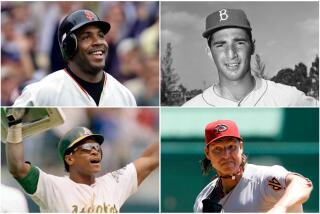First-Year Records in Baseball Often Misleading
NEW YORK — Hank Aaron, baseball’s all-time home run king, hit only 13 home runs in his rookie season. Pete Rose, the game’s all-time hit leader, batted a mediocre .273.
Babe Ruth, whose slugging was credited with saving the game and turning it into a top box office attraction, hit only four home runs in his first season. Of course, he was a pitcher for the Boston Red Sox at the time.
Many of the players currently in the Hall of Fame and those destined to join the shrine when they are eligible did not have exceptionally good rookie years. For example, Ty Cobb, who posted the highest lifetime batting average (.367), hit only .240 in 41 games. And Lou Brock, who collected 3,023 hits and stole a record 938 bases, batted just .263 and stole just 16 bases in his rookie campaign.
It took time for those players to develop into outstanding players but once they reached their full maturity they were at the top of their profession for many years.
A standout rookie season does not mean instant stardom. Take the case of Walt Dropo. Dropo was a 6-5, 220-pound former college basketball star who joined the Boston Red Sox in 1950 and was the second coming of Jimmie Foxx. In 136 games, Dropo batted .322 with 34 home runs and tied teammate Vern Stephens for the American League runs-batted in lead with 144. He was easily named AL Rookie of the Year.
Dropo never came close to achieving those kinds of numbers again. Although he played 12 more seasons in the major leagues, he never hit as many as 30 homers, drove in as many as 100 runs or hit .300 again.
Then there’s the story of Jim Finigan. Jim earned the starting third base job for the Philadelphia Athletics in 1954 and finished among the AL leaders in batting average with a .302 mark in 136 games. He slumped to .255 the following season when the team moved to Kansas City and by 1956 was no longer a regular.
And, how about pitchers Harry Byrd and Don Schwall? Both were named AL Rookies of the Year and faded quickly into oblivion. Byrd posted a 15-15 record for the Philadelphia Athletics in 1952 to win top rookie honors. The next year he lost 20 games and by 1958 he was gone.
Schwall had a similar career. He posted a 15-7 record for the 1961 Boston Red Sox to win the AL Rookie of the Year award. He never won in double figures again and was gone by 1968.
More recently, the fall of Joe Charboneau is a case study on how fleeting fame can be. Charboneau was the AL Rookie of the Year with Cleveland in 1980 when he batted .289 with 23 homers and 87 RBI in 131 games. He was such a popular and colorful player that a ballad was written about him. A year later, bothered by a bad back, he was in the minor leagues. By 1983 he was out of the majors for good.
Of course, there are some players who had great rookie seasons and kept getting better much to the dismay of opposing pitchers. Ted Williams, a member of the Hall of Fame, drove in a rookie record 145 runs in his first season of 1939 and did not fall below 100 RBI in a season for the next decade.
Frank Robinson, another Hall of Fame member, hit a record-tying 38 home runs in his rookie season of 1956 to win National League Rookie of the Year honors. His next season he hit 29 homers and then went over 30 homers in each of his next five seasons.
Tony Oliva was the AL batting champion for the Minnesota Twins in his rookie season of 1964. He also led the league in hits, doubles and runs scored that year in winning the Rookie of the Year award. To prove he was no flash in the pan, Tony won the batting title and led the league in hits in his sophomore season, becoming the only player in baseball history to lead the league in batting his first two seasons.
Ralph Kiner, another member of the Hall of Fame, won the NL home run crown in his rookie year of 1946 and went on to lead the league in home runs for a record seven consecutive seasons.
More to Read
Go beyond the scoreboard
Get the latest on L.A.'s teams in the daily Sports Report newsletter.
You may occasionally receive promotional content from the Los Angeles Times.










